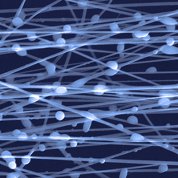
On the Cover
Researchers at the Midwest Cancer Nanotechnology Training Center are developing a blood clot-mimicking patch capable of delivering drugs at an implantation site in a controllable manner. The patch, consisting of drug-releasing microparticles bound to directionally aligned microfibers, was formed through a unique electrospinning/electrospraying process. The image shows the 2-6-micrometer-thick microparticles attached to the 1-micrometer-thick microfibers.
Ross Devolde & Hyunjoon Kong, NCI





